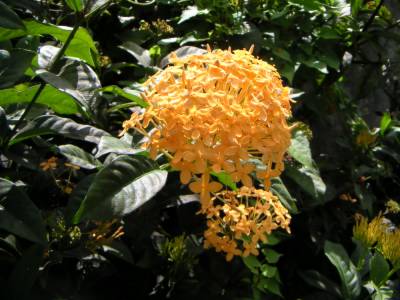
#2 Nature
Martinique is a hilly island with 400,000 inhabitants. There's a highway featuring round-the-clock traffic jams, but you have abandoned cars being reclaimed by vegetation to look at to pass the time. There are no trains but there are old buses and unreliable boats mascarading as public transportation.
The hills are called mornes. The newer roads are straighter, imposing their will on the environment. The older roads snake up and down. When building a house, the disadvantage is that you're most likely to be on a slopey plot. The advantage is that a well-situated slopey plot gives you an awesome, kilometers-long view. Higher than the hills is the Montagne Pelée, a volcano that last erupted in 1902, razing the city of Saint-Pierre and famously leaving a prisoner under thick fortifications as lone survivor.
There's the Atlantic side and the Carribbean side. The former is wilder, with black sand beaches, colder water and dangerous currents. The latter is more swimmer- and lounger-friendly. The Carribbean side decisively shaped my opinion of what a sea was: small, curved beaches with white-ish sand, blue water and brown seaweed. Hence my enduring repulsion at the idea of bathing at Brighton Beach. Some beaches have little bits of mangrove. These used to be considered foul mosquito breeding grounds. Later, too much later, their ecological importance was recognised.
One of the first animals I met was a red and black crab, affectionately known as a loulou. He tried to run (or side-scramble) away through the grass, but when I got close to him he stopped and confronted me. He spread his claws wide and seemed to be saying You want some of this, ese?, just like a Latino gangster from Los Angeles. I don't know where a Martiniquan crab would have picked that up from. There are also fireflies, known more elegantly in french as lucioles and awesome red dragonflies, which are called an overly cutesy libellule.
As my father and I walked down Fort-de-France's sea front, schools of small fish suddenly appeared out of the water like a bad rash, looking and sounding like they'd been dropped on a hot skillet.
In the late afternoon, the symphony of frogs and crickets starts up. It's not something that starts or ends: at some point you realise that it has started, but can't know how long it has been going on; it stops during your sleep. The frogs provide a continuous, undulating and mellifluous texture, which the crickets overlay with their shrill high-pitched drones. If I knew anything about Minimalism, I'd probably draw a comparaison. Feel free to do so now, if you have such knowledge.
Among other things, there are plants whose leaves close when you touch them and at night when they go to sleep.
skip to main |
skip to sidebar
freeform jazz will destroy the world
does be.jazz need more MP3s?
get in touch
you said
categories
head out
further reading
further further reading
musician blogs
- Alexander Hawkins
- Armen Nalbandian
- Babel Records
- Bobby Broom
- Christian McBride
- Clap Clap
- Classical Pontifications
- Darcy James Argue
- Dark Forces Swing Blind Punches
- Dave Douglas
- David Valdez
- Do You Come Here Often?
- Downbeast
- Forces of Circumstance
- Greg Sandow
- Holey Lint Out Two Alewife
- HurdAudio
- Improvising Guitar
- It Is Not Mean If It Is True (Attack Attack Attack)
- Jazz: The Music of Unemployment
- JazzWord
- Jeff Parker
- Laurent De Wilde
- M-Base Blog
- Manuel Marches
- Matana Roberts
- Natamusica
- Ned Goold
- Nico Muhly
- Occasional Jazz Conjectures
- Postclassic
- Pulse
- Scratch My Brain
- Settled in Shipping
- Shadows of a People
- SloaneView
- SpiderMonkey Stories
- Stephen Haynes
- Stochasticactus
- stop the play and watch the audience
- surviving the crunch
- The 5th Sharp
- THE ?uestosphere!!!!!!!!!!!
- The Bad Plus
- The Soul and the System
- The Spit Valve
- The Zone | Jessica Williams
- Think Denk
- ThinkSong
- Tie A Bow Not A Knot
- visionsong
- Words from the Front
- Yvinek
multimedia blogs
music writer blogs
- Alex Ross
- allegro vivace
- Bagatellen
- BBC jazz blog
- Don't Explain
- erg
- Fred Kaplan
- Free Jazz
- Jazz (or Jass)
- Jazz and Blues Music Reviews
- Jazz Beyond Jazz
- Jazz Chronicles
- Jazz Frisson
- Jazz Workshop
- Jazzman
- Jazzques
- JazzWax
- Just Outside
- K-Punk
- ListenGood
- Lulu's Back In Blog
- MetalJazz
- Night After Night
- Rifftides
- Running The Voodoo Down
- s/fj
- Scribe Life
- Simon Reynolds
- Song With Orange
- Sound of Jazz
- SoundSlope
- St. Louis Jazz Notes
- Status Ain't Hood
- Streams of Expression
- The Jazz Clinic
- The Rambler
- Tom Hull
- Wall of Sound
- Zoilus
|